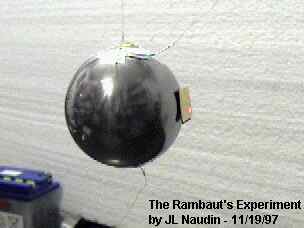

The Michel Rambaut's Spinning Ball experiment
Tests and Design by Jean-Louis Naudin
created on 11/19/97 - JLN Labs - last update on 11/23/97
The Dr. Rambaut's spinning ball experiment : ( extract from the Patrick Cornille's document )
"Dr. M. Rambaut is a retired scientist from the French Atomic Energy Commission who published several papers on the Ampère force and the cold fusion problem (12-17). He participated to the pendulum experiments described above. After witnessing the translation motion of the electrostatic bi-filar pendulum, not knowing Deyo's experiments, Dr. Rambaut duplicated these experiments in a different manner since he used a one ball pendulum connected to a low voltage generator (12 V) with a high current (4 A) crossing the metallic ball. The experiment is so simple that any reader can repeat it in his garage and convince himself of the veracity of our assertion concerning the existence of the spontaneous force. It suffices to connect a car battery with wires to the metallic ball. One must use very thin wires in order to provide the necessary resistance to avoid short-circuit the battery. Moreover, the fineness and the flexibility of the wires which must be hung from the ceiling prevent any mechanical coupling through an heating process between the wires and the ball (m = 0.5 Kg). As soon as the current is turn on, one can see, if the experiment is properly done, a rotation and a small translation of the ball. These effects can certainly not result from any wind effect or induction effects. To increase the translation effect, one can oscillate the D. C. voltage in phase with the oscillatory motion of the pendulum. The fact that the amplitude of the oscillatory motion increases is a proof that the spontaneous force is an external force whose work increases the kinetic energy of the pendulum as anybody who has played with a swing in his youth knows very well."



Notes from Jean-Louis Naudin (11/19/97) : Today, I have reproduced successfully the Michel Rambaut's spinning ball experiment. This experiment may be reproduced easily by anyone at LOW VOLTAGE ( 12V DC). When the current (about 3A) flows through the hollow steel ball , the ball begins to rotate around its main axis ( with about 45 degres deviation ). If you send DC pulses with the main switch ( at about 8 seconds duration period ), the ball oscillates with a great amplitude. If the current is reversed, you may stop the initial oscillation and the ball restarts to oscillate in the other direction.
See also the Pulses generator electronic diagram.
Back to the Electrostatic Pendulum home page